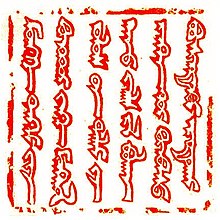تنكري
| صنف فرعي من | |
|---|---|
| الولد | |
| يعبده | |
| نطاق القديس أو الإله | |
| موجود في عمل |
تنكري (Tengri) (باللغة التركية القديمة *تنكري (teŋri) / *تانكري (taŋrɨ)؛ تنكري (Tngri)؛ بالمنغولية الحديثة: Тэнгэр، تنجر (Tenger)؛ باللغة التركية الحديثة: تانري)، هو واحد من أسماء أكبر وأهم إله في عقيدة الترك (شاجنوو (Xiongnu)، والهون، والبلغار القدماء) والمنغوليين (زيانبي (Xianbei)).
ويُشار إلى عبادة التنكري عادةً بـ تنكيرية. إن الكائنات الرئيسية في التنكرية هي الأب السماوي (Sky-Father) (تنكري/تنكر إستج) (Tengri/Tenger Etseg) والأرض الأم (Mother Earth) (أوماي/جازار إيج) (Eje/Gazar Eej). وشملت الشامانية والإحيائية والطوطمية وتبجيل الأموات.
معلومات تاريخية
[عدل]
كان تنكري هو الإله القومي للـغوكتورك، ووصِفَ ب«إله الترك» (تورك تنكريزي (Türük Tängrisi)). وقد أقام خانات الغوكتورك حكمهم على أساس وصاية من تنكري. وعُرِفوا عامةً بأنهم أبناء تنكري الذي مثلهم في الأرض. وحملوا ألقاب تنكريكوت (tengrikut)، وكوتلوغ (kutluġ)، وكوتلاميش (kutalmysh)، على أساس اعتقادهم بأنهم نالوا الكوت (kut)، وهي الروح العظيمة التي يمنحها تنكري لهؤلاء الحكام.[1]
كان تنكري هو الإله الرئيسي الذي عبدته الطبقة الحاكمة الرُّحّل الأوراسيين بين القرنين السادس والتاسع (الـترك، والـمغول، والمجريين).[2]
لقد قام الهون والبلغار القدماء بنقل عبادة التنكري إلى أوروبا الشرقية. ولكنها فقدت أهميتها عندما أعلن خاقانات الأويغور الـمانوية باعتبارها الديانة الرسمية في القرن الثامن.[3]
أسَّس كبار الخانات المنغوليين في القرن الثالث عشر حكمهم بالتوافق مع وصاية تنكري ذاته، وبدأوا بياناتهم بالكلمات "بإرادة السماء [الزرقاء] الأبدية" (by the will of Eternal [Blue] Heaven").
إن مفهوم الإله السماوي لدى المغول الأتراك له نظير في كلمات الـطاوية المستحدثة ل靝 (مع 青 «أزرق» و氣 «سماء»، أي «السماء الزرقاء») والمفهوم الكونفوشيوسي لتيان (Tian) لي (Li).
انظر أيضًا
[عدل]- ميثولوجيا الشعوب التركية والمنغولية
- الذئب (Wolf Totem) (رواية صينية)
ملاحظات
[عدل]- ^ Käthe Uray-Kőhalmi, Jean-Paul Roux, Pertev N. Boratav, Edith Vertes. "Götter und Mythen in Zentralasien und Nordeurasien"; section: Jean-Paul Roux: "Die alttürkische Mythologie" ("Old Turkic Mythology") ISBN 3-12-909870-4
- ^ "There is no doubt that between the 6th and 9th centuries Tengrism was the religion among the nomads of the steppes" Yazar András Róna-Tas , Hungarians and Europe in the early Middle Ages: an introduction to early Hungarian history, Yayıncı Central European University Press, 1999, ISBN 978-963-9116-48-1, p. 151. نسخة محفوظة 24 مارس 2017 على موقع واي باك مشين.
- ^ Buddhist studies review, Volumes 6-8, 1989, p. 164.
المراجع
[عدل]- Brent, Peter. The Mongol Empire: Genghis Khan: His Triumph and his Legacy. Book Club Associates, London. 1976.
- Sarangerel. Chosen by the Spirits. Destiny Books, Rochester (Vermont). 2001
- Schuessler, Axel. ABC Etymological Dictionary of Old Chinese. University of Hawaii Press. 2007.
- Georg, Stefan. „Türkisch/Mongolisch tängri “Himmel/Gott” und seine Herkunft“, "Studia Etymologica Cracoviensia 6, 83-100
- Bruno J. Richtsfeld: Rezente ostmongolische Schöpfungs-, Ursprungs- und Weltkatastrophenerzählungen und ihre innerasiatischen Motiv- und Sujetparallelen; in: Münchner Beiträge zur Völkerkunde. Jahrbuch des Staatlichen Museums für Völkerkunde München 9 (2004), S. 225–274.
- Yves Bonnefoy, Asian mythologies, University of Chicago Press, 1993, ISBN 978-0-226-06456-7, p. 331.
وصلات خارجية
[عدل]- Tengri Teg Tengri Created Türk Bilge Kagan (Orkhon Inscriptions)
- Excerpt from Tengrianizm: Religion of Turks and Mongols, by Rafael Bezertinov (2000)
- Andrei Vinogradov Ak Jang in the contextof Altai religious tradition (2003)
- Hasan Bülent Paksoy, Tengri on Mars (2010)
- Virtual Temple of Tengri
Text is available under the CC BY-SA 4.0 license; additional terms may apply.
Images, videos and audio are available under their respective licenses.

